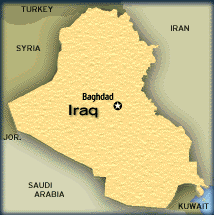 THE
HEART OF IRAQ lies over the site of one of the first
agricultural civilizations - Sumer (also refered to as Babylonia, Eden, or Mesopotamia) -
at the confluence of the Tigris and Euphrates Rivers. But the nation of Iraq is relatively
young; the country achieved independence in 1932. Since then, Iraq has been almost
perpetually at war with its neighbors. Saddam Hussein invaded Kuwait in 1990, leading to
the 1991 Persian Gulf War. Iraq has been under international sanctions since the invasion,
and the United Nations refused to lift them until it is convinced that Iraq has eliminated
its weapons of mass destruction. The United States and Britain threatened air strikes in
1998 over Iraq's refusal to allow U.N. weapons inspectors free access to all sites. The
United States and its allies patrol a no-fly zone over northern Iraq to protect Kurds from
attack and in the south to protect Shiite Muslims. THE
HEART OF IRAQ lies over the site of one of the first
agricultural civilizations - Sumer (also refered to as Babylonia, Eden, or Mesopotamia) -
at the confluence of the Tigris and Euphrates Rivers. But the nation of Iraq is relatively
young; the country achieved independence in 1932. Since then, Iraq has been almost
perpetually at war with its neighbors. Saddam Hussein invaded Kuwait in 1990, leading to
the 1991 Persian Gulf War. Iraq has been under international sanctions since the invasion,
and the United Nations refused to lift them until it is convinced that Iraq has eliminated
its weapons of mass destruction. The United States and Britain threatened air strikes in
1998 over Iraq's refusal to allow U.N. weapons inspectors free access to all sites. The
United States and its allies patrol a no-fly zone over northern Iraq to protect Kurds from
attack and in the south to protect Shiite Muslims. 

People |

Languages |

Arabic, Kurdish (official in Kurdish
regions), Assyrian, Armenian |
| Major Religions |
Muslim
97% (Shi'a 60%-65%, Sunni 32%-37%), Christian or other 3% |
| Ethnic groups |
Arab
75%-80%, Kurdish 15%-20%, Turkoman, Assyrian or other 5% |
| Growth rate |
3.2% |
| Birth rate |
38.58
births/1,000 |
| Death rate |
6.57
deaths/1,000 |
| Fertility rate |
5.23
children/woman |
| Male life expectancy |
65 |
| Female life expectancy |
67 |
| Infant mortality rate |
62.41
deaths/1,000 live births |


Economy |

Labor force |

4.4 million (1996) |
| Unemployment rate |
N/A |
| Inflation Rate |
N/A |
| Gross domestic product (total value of goods and services produced annually) |
$42.8
billion (1997 est.) |
| Budget |
N/A |
| Debt |
$50.0
billion (1989) |
| Exports |
N/A |
| Imports |
N/A |
| Defense spending |
N/A |
| Highways |
47,400 km
(1996) |
Source: 1998 CIA World Factbook

|

